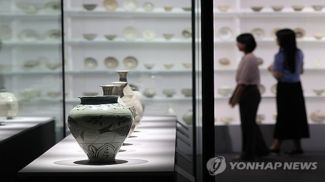SHANXI, 3 August (BelTA - China Daily). - Shanxi Museum's relic protection team restores the glory and craftsmanship of a bygone era, report Yang Feiyue in Beijing and Sun Ruisheng in Taiyuan.
One can't help but notice the curious emblem outside the four-story main hall at Shanxi Museum in Taiyuan, Shanxi province. It features a phoenixlike bird, the proud head raised and turned toward the tail in a posture of self-admiration.
The emblem is inspired by a rare treasure the museum holds: a bird-shaped bronze zun (wine vessel) from the Western Zhou Dynasty (c.11th century-771 BC). The body is plump and the wings are curled up. The tail curves downward like an elephant's trunk to form a point of support, along with the two feet. The vessel boasts intricate and exquisite patterns.
What is more remarkable though is how the zun was resurrected after tomb robbers triggered a blast, reducing it to more than 100 pieces.
It took cultural relic restorers a year and a half to collect all the fragments, clean them, treat them for discoloration and meticulously piece together the vessel, with just a few nicks remaining in the tail.
"When you see the artifact now, you can't imagine that it was found in pieces during excavation. It is so lifelike once more," says Zhang Zhengmin, 30, who studied cultural relic authentication and restoration at Shanxi Vocational College of Tourism in Taiyuan.
A dream project
For Zhang, who was already into folk culture and history, and had learned about clay sculptures, a career in restoration of relics was an obvious choice.
However, in 2013, a year before graduation, when he received an offer from the cultural relic protection and research department of Shanxi Museum, he came to realize that the job was far more complicated than he had expected.
Zhang spent the first three months just matching and numbering bronze debris. "Only senior experts were entrusted with actual restoration work," he recalls.
It wasn't until the fourth month that he was asked to piece together a bronze cylinder. "At first, I had no idea about its shape. My instructor guided me through a series of operations, including matching and mending. When I finished two-thirds of the work, the ancient relic roughly revealed itself, and I couldn't have been prouder," he says.
It took Zhang about two months to complete his first cultural relic restoration. Thereafter, he continued to hone his skills through various projects.
In 2019, he participated in the mission of his dreams. Debris that were believed to be the missing pieces of the tail of the wine vessel from the Western Zhou Dynasty were found at the tomb by faculty members and students of Peking University.
"I was thrilled to join the restoration work and was determined to make the zun look as if it were never damaged, so that more people could appreciate its beauty," he says.
Dogged perseverance and 12 restoration steps later, Zhang and his teammates eventually pulled off the job, bringing an almost intact historical wine vessel before the public.
A scientific bent of mind with full grasp of mathematics, physics and chemistry, and the ability to ascertain problem areas through technology, such as X-rays, are among the core requirements to successfully finish complicated projects, he stresses.
Zhang is among the 11 young restorers at the museum's cultural relic protection and research department, which was founded in 2005 and is the first of its kind in Shanxi.
The restorers account for one-third of the staff, and are strong pillars of the museum, says Guo Zhiyong, deputy director of the department.
These young people engage in cultural relic testing, damage detection, sterilization, and related physics and chemistry experiments to return historical items to their former glory.
They are the unsung heroes behind the scenes, Guo adds.
Hui Mingtao, another member of the team, won third prize at a national cultural relic vocational skills competition in October for restoring a couplet dating back to the Qing Dynasty (1644-1911).
"The couplet was 'fractured' and parts of it were missing. The color had faded, and the writings in ink were blurry," he recalls.
After analyzing all the problems, he embarked on a three-month restoration project and returned the couplet to its original state through a dozen steps.
Like Zhang, Hui studied cultural relic authentication and restoration in college, and has focused his attention on ancient painting and calligraphy work at the Shanxi Museum since 2013. It took him three years to learn to manage the simplest repair job.
"Meticulousness must be your second name if you wish to be a restorer," Hui says.
For example, he says, removing pollutants and residue is like dealing with wounds during a surgery. Most ancient calligraphy works are very fragile and can fall apart if not handled with utmost care.
Hui raised his threshold for challenges in 2018, when he was working on a couplet by well-known calligrapher Yang Eryou from the Qing Dynasty.
Normally, it takes three to five days to brush away the residue, but this couplet had been inappropriately mended before, making things more complicated. Hui had to spend a month doing the basics.
"I was on the verge of giving up out of frustration," he recalls. But when the calligraphy finally revealed itself, he realized it was worth all the trouble.
Practice makes perfect
Fascinated by the stories his parents told him when he was a child, Sun Chengzhuo wanted to pursue a career in culture and history.
For the 29-year-old, it was a dream come true when he got the opportunity to restore ceramics at the museum in 2013.
Sun's job is divided into three phases that cover cleaning, mending, as well as polishing and coloring. "There's a lot to learn in every step. One needs to study extensively about restoration work and practice continuously to be perfect in the trade," he says.
One of Sun's most memorable experiences was restoring a flask from the Qing Dynasty. "There was an oblique triangular gap in the relic," he recalls.
He found inconsistencies even after he filled it in. "I reviewed every detail for nearly four months and finally realized I was wrong about the flask's shape in the first place."
Challenges include recovering the complex transmutation of colors that were rendered in a kiln. "Perfection doesn't mean everything must look exactly like before," Sun says, adding that risks should be controlled and a principle of minimal interference followed.
"It is the only responsible way to restore cultural relics."
Sun admits that his concepts about restoration work are still evolving with experience. "Repairing them is like repairing history," he says.
In May, the local authorities issued a notice, offering free training to those interested in restoring cultural relics.
Approximately, 600 students will graduate in the discipline from Shanxi University in 2025. They will form a new army of frontline workers who will give historical artifacts a fresh lease of life.













